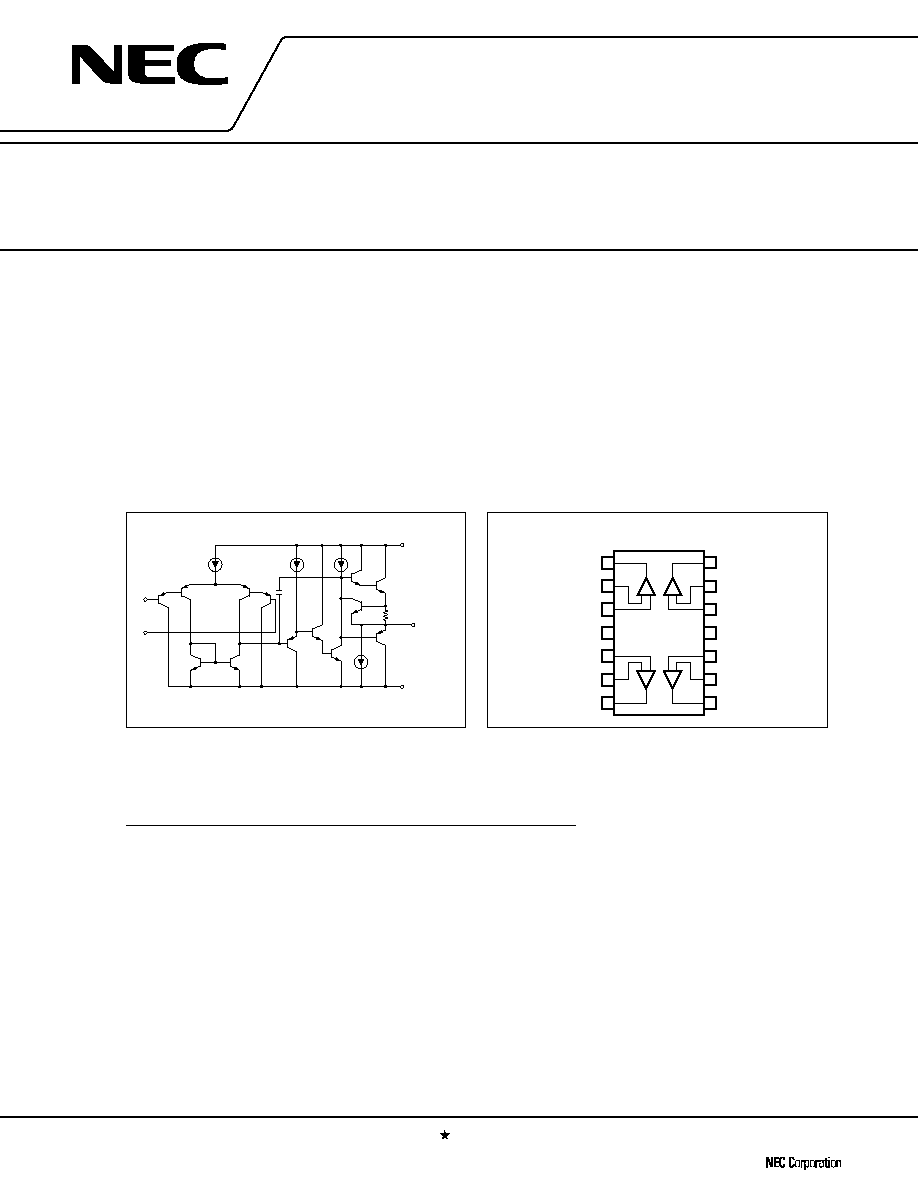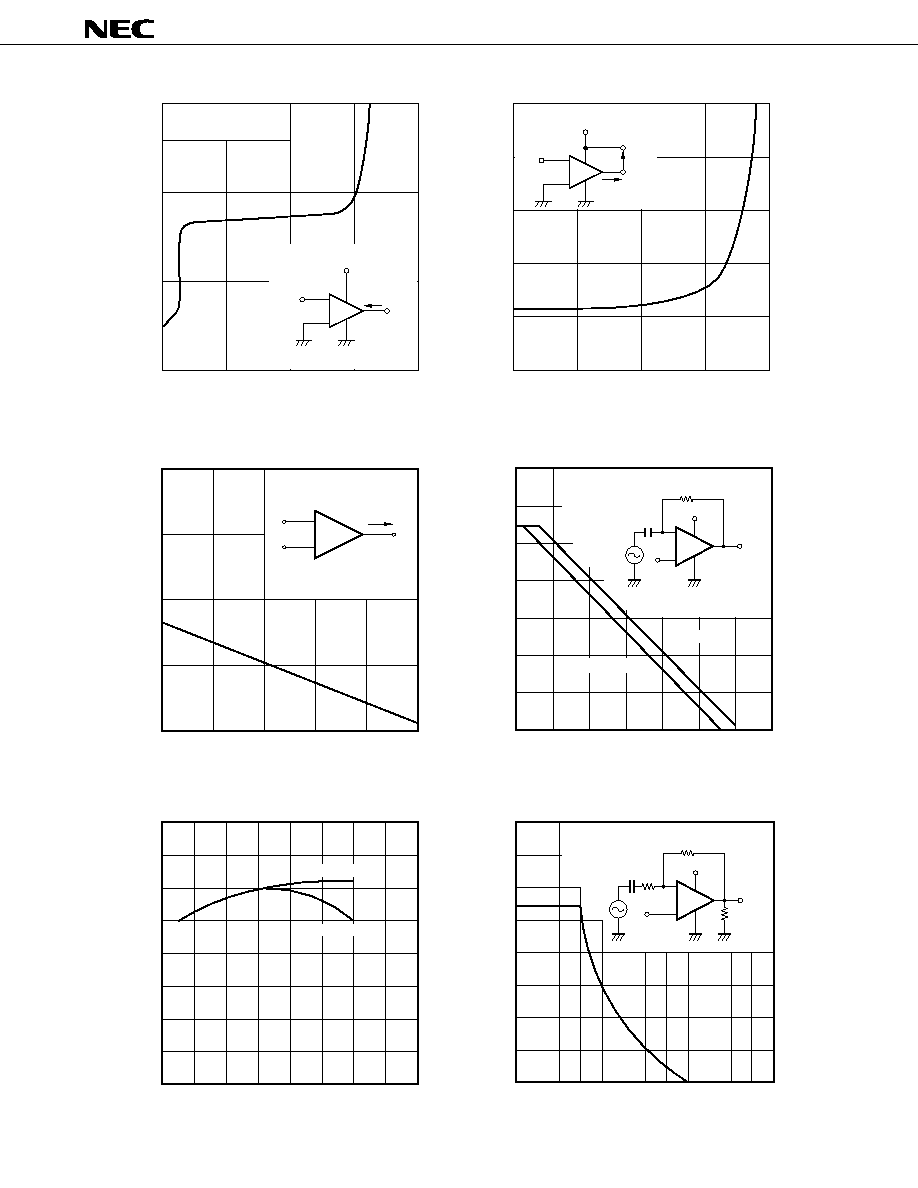 | –≠–ª–µ–∫—Ç—Ä–æ–Ω–Ω—ã–π –∫–æ–º–ø–æ–Ω–µ–Ω—Ç: C324C | –°–∫–∞—á–∞—Ç—å:  PDF PDF  ZIP ZIP |
Document Outline
- COVER
- DESCRIPTION
- FEATURES
- EQUIVALENT CIRCUIT (1/4 Circuit)
- PIN CONFIGURATION (Top View)
- ORDERING INFORMATION
- ABSOLUTE MAXIMUM RATINGS (TA = 25 degree)
- RECOMMENDED OPERATING CONDITIONS
- ELECTRICAL CHARACTERISTICS (TA = 25 degree, V + = 5 V, V - = GND)
- TYPICAL PERFORMANCE CHARACTERISTICS (TA = 25 degee, TYP.)
- PACKAGE DRAWINGS
- RECOMMENDED SOLDERING CONDITIONS
- REFERENCE DOCUMENTS

©
1997
DATA SHEET
BIPOLAR ANALOG INTEGRATED CIRCUIT
µ
PC324
LOW POWER QUAD OPERATIONAL AMPLIFIER
DESCRIPTION
The
µ
PC324 is a quad operational amplifier which is
designed to operate from a single power supply over a
wide range of voltages. Operation from split power
supplies is also possible and the power supply current
drain is very low. Further advantage, the input common-
mode voltage can also swing to ground in the linear
mode.
Document No. G11763EJ3V0DS00 (3rd edition)
(Previous No. IC-1985)
Date Published April 1997 N
Printed in Japan
FEATURES
∑
Internal frequency compensation
∑
Wide output voltage swing V
≠
to V
+
≠1.5 V
∑
Common Mode input voltage range includes V
≠
∑
Wide supply range
3 V to 30 V (Single)
±
1.5 V to
±
15 V (Split)
∑
Output short circuit protection
EQUIVALENT CIRCUIT (1/4 Circuit)
PIN CONFIGURATION (Top View)
The mark
shows major revised points.
The information in this document is subject to change without notice.
ORDERING INFORMATION
Part Number
Package
µ
PC324C
14-pin plastic DIP (300 mil)
µ
PC324G2
14-pin plastic SOP (225 mil)
OUTPUT
V
+
V
≠
I
I
I
N
Q
2
Q
1
Q
9
Q
10
Q
11
Q
13
Q
6
Q
5
Q
7
Q
12
Q
4
Q
3
Q
8
R
SC
C
C
6 A
6 A
100 A
50 A
µ
µ
µ
µ
1
2
3
4
5
6
7
14
13
12
11
10
9
8
OUT1
I
I1
I
N1
V
+
I
N2
I
I2
OUT2
OUT4
I
I4
I
N4
V
≠
I
N3
I
I3
OUT3
1
4
2
3
≠ +
≠ +
+ ≠
+ ≠
PC324C, 324G2
µ

µ
PC324
2
ABSOLUTE MAXIMUM RATINGS (T
A
= 25
∞
C)
Parameter
Symbol
Ratings
Unit
Voltage between V
+
and V
≠
Note 1
V
+
≠V
≠
≠0.3 to +32
V
Differential Input Voltage
V
ID
±
32
V
Input Voltage
Note 2
V
I
V
≠
≠0.3 to V
≠
+32
V
Output Voltage
Note 3
V
O
V
≠
≠0.3 to V
+
+0.3
V
Power Dissipation
C Package
Note 4
P
T
570
mW
G2 Package Note 5
550
mW
Output Short Circuit Duration
Note 6
Indefinite
sec
Operating Ambient Temperature
T
A
≠20 to +80
∞
C
Storage Temperature
T
stg
≠55 to + 125
∞
C
Notes 1. Reverse connection of supply voltage can cause destruction.
2. The input voltage should be allowed to input without damage or destruction independent of the
magnitude of V
+
. Either input signal should not be allowed to go negative by more than 0.3 V. The normal
operation will establish when the both inputs are within the Common Mode Input Voltage Range of
electrical characteristics.
3. This specification is the voltage which should be allowed to supply to the output terminal from external
without damage or destructive. Even during the transition period of supply voltage, power on/off etc.,
this specification should be kept. The output voltage of normal operation will be the Output Voltage Swing
of electrical characteristics.
4. Thermal derating factor is ≠7.6 mW/
∞
C when operating ambient temperature is higher than 50
∞
C.
5. Thermal derating factor is ≠5.5 mW/
∞
C when operating ambient temperature is higher than 25
∞
C.
6. Pay careful attention to the total power dissipation not to exceed the absolute maximum ratings, Note
4 and Note 5.
RECOMMENDED OPERATING CONDITIONS
Parameter
Symbol
MIN.
TYP.
MAX.
Unit
Supply Voltage (Split)
V
±
±
1.5
±
15
V
Supply Voltage (V
≠
= GND)
V
+
3
30
V
ELECTRICAL CHARACTERISTICS (T
A
= 25
∞
C, V
+
= 5 V, V
≠
= GND)
Parameter
Symbol
Conditions
MIN.
TYP.
MAX.
Unit
Input Offset Voltage
V
IO
R
S
= 0
±
2
±
7
mV
Input Offset Current
I
IO
±
5
±
50
nA
Input Bias Current Note 7
I
B
45
250
nA
Large Single Voltage Gain
A
V
R
L
2 k
25
100
V/mV
Supply Current
I
CC
R
L
=
, I
O
= 0 A, All Amplifiers
1.0
2
mA
Common Mode Rejection Ratio
CMR
65
85
dB
Supply Voltage Rejection Ratio
SVR
65
100
dB
Output Voltage Swing
V
O
R
L
= 2 k
(Connect to GND)
0
V
+
≠ 1.5
V
Common Mode Input Voltage Range
V
ICM
0
V
+
≠ 1.5
V
Output Current (SOURCE)
I
O SOURCE
V
IN
+
= +1 V, V
IN
≠
= 0 V
20
40
mA
Output Current (SINK)
I
O SINK
V
IN
≠
= +1 V, V
IN
+
= 0 V
10
20
mA
V
IN
≠
= +1 V, V
IN
+
= 0 V, V
O
= 200 mV
12
50
µ
A
Channel Separation
f = 1 kHz to 20 kHz
120
dB
Notes 7. Input bias currents flow out from IC. Because each currents are base current of PNP-transistor on input
stage.

µ
PC324
3
TYPICAL PERFORMANCE CHARACTERISTICS (T
A
= 25
∞
C, TYP.)
1000
800
600
400
200
4
3
2
1
0
20
40
60
80
100
0
10
20
30
40
T
A
- Operating Ambient Temperature - ∞C
P
T
- Total Power Dissipation - mW
POWER DISSIPATION
I
CC
- Supply Current - mA
SUPPLY CURRENT
V+ - Supply Voltage - V (V≠ = GND)
T
A
= ≠20 ∞C
T
A
= 0 to 70 ∞C
324G2
324C
100
75
50
25
0
10
20
30
40
V+ - Supply Voltage - V (V≠ = GND)
I
B
- Input Bias Current - nA
INPUT BIAS CURRENT
T
A
= +25 ∞C
≠
+
A
V
+
I
CC
3
2
1
0
0
10
20
30
50
V
IO
- Input Offset Voltage - mV
INPUT OFFSET VOLTAGE
V+ - Supply Voltage - V (V≠ = GND)
T
A
= 25 ∞C
0
40
100
≠50
≠4
≠3
≠2
≠1
1
0
2
3
4
5
INPUT OFFSET VOLTAGE
V
+
= 5 V
T
A
- Operating Ambient Temperature - ∞C
100
80
60
40
20
0
≠50
0
50
100
INPUT BIAS CURRENT
T
A
- Operating Ambient Temperature - ∞C
V
+
= +15 V
V
≠
= GND
V
IO
- Input Offset Voltage - mV
I
B
- Input Bias Current - nA

µ
PC324
4
140
120
100
80
60
40
20
0
1
10
100
1 k
10 k 100 k
1 M
10 M
f - Frequency - Hz
OPEN LOOP FREQUENCY RESPONSE
A
V
- Open Loop Voltage Grain - dB
V
+
= 10 to 15 V
V
+
= 30 V
V
+
/2
V
O
V
+
V
IN
0.1 F
10 M
+
≠
20
15
10
5
0
1 k
3
5 10 k
30 50 100 k
300 500 1 M
LARGE SIGNAL FREQUENCY RESPONSE
V
om
- Output Voltage Swing - V
p-p
V
O
V
IN
100 k
1 k
+15 V
7 V
+
≠
2 k
160
120
80
40
70
60
50
40
30
0
10
20
30
40
≠20
60
20
80
OPEN LOOP VOLTAGE GAIN
T
A
- Operating Ambient Temperature - ∞C
I
O SHORT
- Output Short Circuit Current - mA
OUTPUT SHORT CIRCUIT CURRENT
0
40
I
O SHORT
≠
+
V
+
- Supply Voltage - V (V
≠
= GND)
R
L
= 20 k
R
L
= 2 k
µ
f - Frequency - Hz
A
V
- Open Voltage Gain - dB
OUTPUT SINK CURRENT LIMIT
V
O
- Output Voltage - V
10
1.0
0.1
0.01
0.01
0.1
1.0
10
100
I
O
SINK
- Output Sink Current - mA
V
+
= 15 V
≠
+
V
O
V
+
/2
V
+
I
O
SINK
OUTPUT SOURCE CURRENT LIMIT
V
O
- Output Voltage to V
+
- V
5
4
1
0
0.01
0.1
1.0
10
100
I
O
SOURCE
- Output Source Current - mA
+
≠
I
O
SOURCE
V
+
/2
V
+
V
O
3
2

µ
PC324
5
4
3
2
1
0
3
2
1
0
20
40
60
80
Time - s
R
L
2 k
V
+
= 15 V
Input
Voltage - V
Output
Voltage - V
120
100
80
60
40
20
0
100
1 k
10 k
100 k
1 M
f - Frequency - Hz
CMR - Common Mode Rejection Ratio - dB
COMMON MODE REJECTION RATIO
0.2
≠50
0
50
100
T
A
- Operating Ambient Temperature - ∞C
SR - Slew Rate - V/ s
SLEW RATE
0.3
0.1
0
V
±
= ±15 V
V
O
= ±10 V
SR
≠
SR
+
VOLTAGE FOLLOWER PULSE RESPONSE
µ
µ




